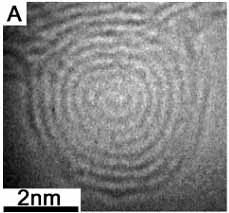
How Logarithmic Spirals Grow
Among
a variety of morphologies of creatures, our special interest is in logarithmic
spiral. We have found formation of spiral nanocarbons out of carbon black
consist of very small sized primary particles under intense electron beam
irradiation a few decades ago. Spherical spiral nanoparticles were observed as
precursors of carbon nanoonions, i.e. multi-shell fullerenes, which had been
already known to form. The lower right figure shows an example of electron
microscopy images[1]. A particle having 8 layers is visible, in which a
continuous layer indeed winds from the center, if one looks carefully. We were
lucky enough to find such a wonderful spiral. Spirals having constant
interlayer distances like the figure are called as Archimedean spirals. Screw
dislocation sometimes observed during crystal growth processes is also in the
same category, implying accessible by our technology. On the other hand, the
spirals abundant in nature like shells, horns, etc. are logarithmic spirals.
Despite abundance, there have been only 1 man-made example, as far as we know,
which accidentally form in 2D on a flat substrate by a mechanism relying on the
very specific nature of the system. No example of 3D ones like shells or horns
have seemingly been known yet. So why not try? It is not sure if it is possible
to grow it without living organisms. As the issue seems challenging enough to
make us tackle endlessly, we are going easy.
|
|
|
|
||||||
| Spherical carbon nanoparticle with a spiral structure[1]. |
| |||||||
[1] "Continuously growing spiral carbon nanoparticles as the intermediates in the formation. of fullerenes and nano-onions." M. Ozawa, H. Goto, M. Kusunoki, and E.Ōsawa, J. Phys. Chem. B 106, 7135-7138 (2002).


